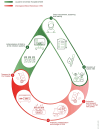Bridging the Milk Gap: Integrating a Human Milk Bank-Blood Bank Model to Reinforce Lactation Support and Neonatal Care
- PMID: 40507034
- PMCID: PMC12158243
- DOI: 10.3390/nu17111765
Bridging the Milk Gap: Integrating a Human Milk Bank-Blood Bank Model to Reinforce Lactation Support and Neonatal Care
Abstract
Mother's own milk (MOM) offers the highest protection for preterm and low birth weight infants. However, breastfeeding can be challenging during neonatal hospitalization. When MOM is unavailable, donor human milk (DHM) is the recommended alternative for feeding vulnerable neonates. Human milk banks (HMBs) collect, process, and deliver DHM, playing a key role in lactation support and promoting MOM availability. Although HMBs are expanding globally, scale-up remains hindered, restricting equitable DHM access. In Switzerland, despite the existence of eight HMBs, the western region lacked such a facility until 2022. To address this gap, an interdisciplinary team from the Lausanne University Hospital (CHUV) and the Swiss Red Cross Interregional Blood Transfusion Centre (TIR) collaborated to establish a regional HMB. This partnership leveraged both institutions' available expertise, infrastructure, and resources. After two years of preparation, the CHUV Lactarium launched in 2022 with the support of the Department of Health and Social Action (DSAS) of the Canton of Vaud. This novel human milk bank-blood bank model is fully integrated into the hospital's neonatal care, nutrition, and breastfeeding programs, operating under a strict quality and coordination system. Since its implementation, the HMB has met 100% of DHM needs, with an 80% breastfeeding bridging rate. It has had a positive impact on neonatal care, family engagement, professional interest, and community awareness of human milk. This case study illustrates how synergistic collaboration can help bridge gaps in establishing a safe, efficient, and equitable HMB model. It also offers a scalable framework adaptable to other settings.
Keywords: Lactarium; Swiss health system; breastfeeding; donor human milk; human milk; human milk bank; infant nutrition; lactation; medical product of human origin; preterm infant; substance of human origin; transfusion; vulnerable neonate.
Conflict of interest statement
All the authors have been implicated in the
Figures
References
-
- Smilowitz J.T., Allen L.H., Dallas D.C., McManaman J., Raiten D.J., Rozga M., Sela D.A., Seppo A., Williams J.E., Young B.E., et al. Ecologies, Synergies, and Biological Systems Shaping Human Milk Composition-a Report from “Breastmilk Ecology: Genesis of Infant Nutrition (BEGIN)” Working Group 2. Am. J. Clin. Nutr. 2023;117((Suppl. 1)):S28–S42. doi: 10.1016/j.ajcnut.2022.11.027. - DOI - PMC - PubMed
MeSH terms
LinkOut - more resources
Full Text Sources
Medical
Miscellaneous



